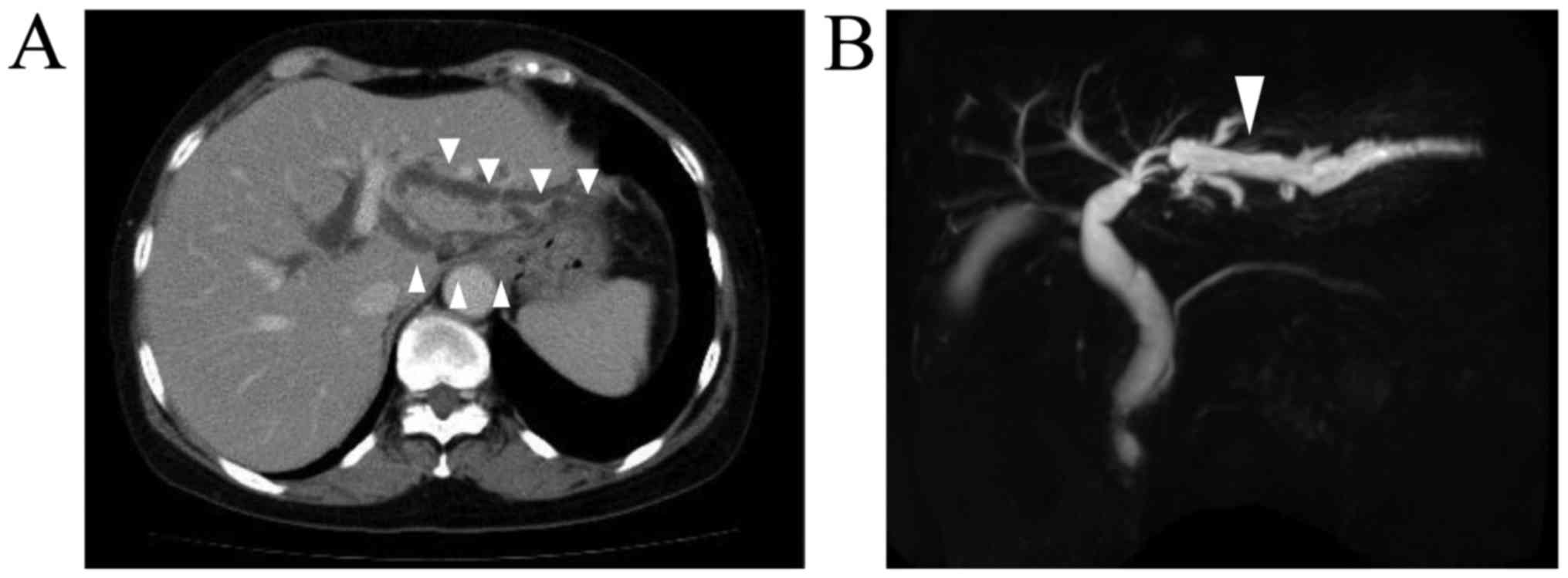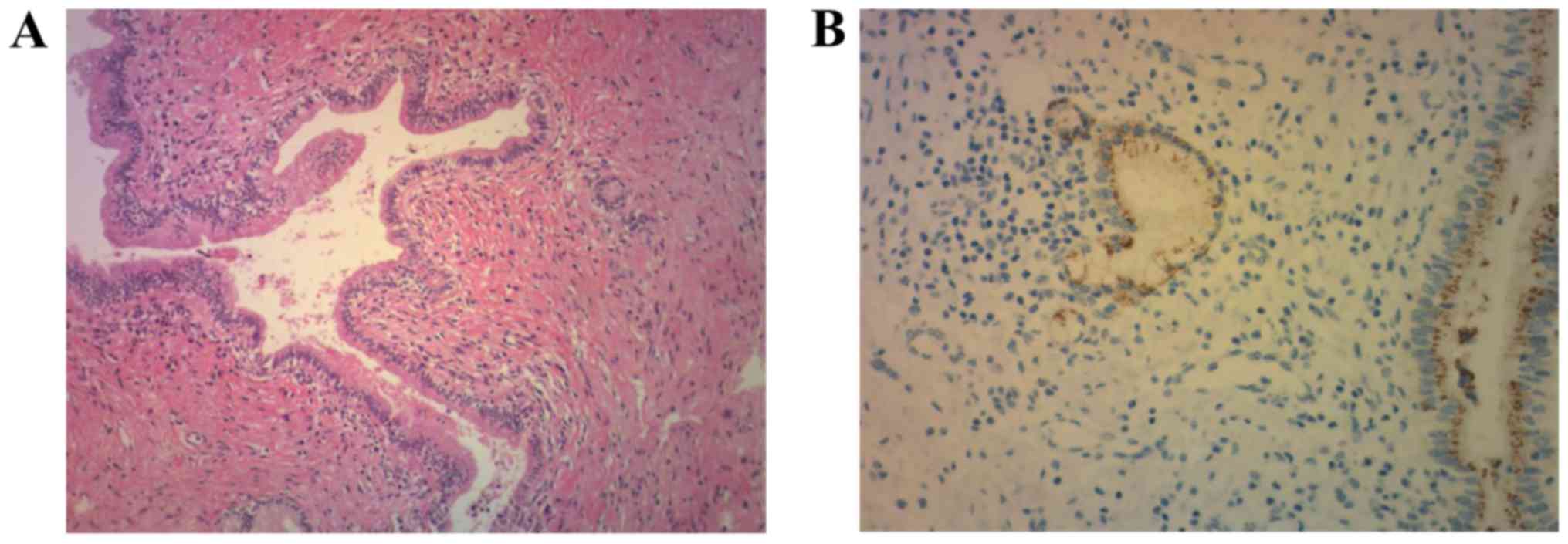Rare case of idiopathic sclerosing cholangitis, which was difficult to distinguish from cholangiocarcinoma: A case report
- Authors:
- Published online on: October 5, 2018 https://doi.org/10.3892/etm.2018.6832
- Pages: 5224-5226
-
Copyright: © Shichi et al. This is an open access article distributed under the terms of Creative Commons Attribution License.
Abstract
Introduction
It is difficult to rule out cholangiocarcinoma in patients with dilated bile ducts. Therefore, clinicians must consider primary sclerosing cholangitis (PSC) and immunoglobulin (Ig)G4-related sclerosing cholangitis (IgG4-SC) as potential diagnoses in such cases. The incidence of benign stricture of the hilar bile duct was reported to be approximately 10% of surgically resected cases involving a preoperative diagnosis of cholangiocarcinoma (1). Most benign hilar strictures detected in surgically resected cases involved PSC, IgG4-SC, or secondary sclerosing cholangitis (SSC). Here, we report a rare case of idiopathic sclerosing cholangitis, which was preoperatively diagnosed as cholangiocarcinoma. This case had some pathological features of SC, but it could not be classified into either of the reported types of benign SCs. So it was diagnosed as an idiopathic sclerosing cholangitis. We report this case including the pathological features about SCs.
Case report
A 73-year-old female presented with high fever and abdominal pain during follow-up after endoscopic mucosal resection (EMR) for gastric cancer. On admission, her laboratory findings were as follows: White blood cell count and C reactive protein level were elevated to 14,960/µl (neutrophils=92.0%) and 23.55 mg/dl, respectively. In addition, her total bilirubin, aspartate aminotransferase, and alanine aminotransferase levels were elevated 0.62 mg/dl, 48, and 39 U/l, respectively. Carcinoembryonic antigen level was within the reference limits, whereas carbohydrate antigen level was slightly elevated, 68 U/ml. Unfortunately, preoperative serum IgG4 was not measured. Postoperative serum IgG4 was measured periodically, but it was within normal range at 10 to 18 mg/dl. Contrast-enhanced computed tomography and magnetic resonance cholangiopancreatography showed stenosis and dilation of the intrahepatic bile duct, in the left hepatic lobe; i.e., within segments 2 and 3 of the liver (Fig. 1). During percutaneous transhepatic biliary drainage, the contrast medium that was injected into the drainage tube could not pass into the center of the bile duct. Endoscopic retrograde cholangiopancreatography revealed obstruction of the intrahepatic bile duct. Scrape cytology of this narrow segment of the bile duct revealed some atypical cells, which were suggestive of hilar cholangiocarcinoma. In addition, follow-up upper endoscopy was conducted, and a biopsy of a scar on the patient's stomach caused by the previous EMR was carried out, which revealed tubular adenocarcinoma. According to these results, we suspected intrahepatic cholangiocarcinoma and diagnosed the patient with locally recurrent gastric cancer. Surgical resection of the liver and stomach were recommended. A lobectomy of the left side of the liver, cholecystectomy, and a distal gastrectomy combined with a D2 lymph node dissection were performed. The operation time was 10 h and 28 min, and 840 ml of intraoperative blood loss occurred. An examination of the surgical specimens showed that the bile duct was thickened and extended and the length of stenosis was 2 cm, but there was no tumor. The patient did not suffer any complications during the postoperative period. A pathological examination of her liver showed marked fibrosis in the stroma and clusters of lymphoid cells. The bile duct exhibited irregular dilation and stenotic compression from the outside, but no thickening of the bile duct wall was noted. No carcinoma or IgG4-positive plasma cells were observed, and we did not detect the typical findings of PSC. The patient had no history of SSC (Fig. 2). Based on these clinical and pathological results, we made a diagnosis of idiopathic sclerosing cholangitis. Incidentally, the pathological findings from the patient's stomach showed early gastric carcinoma, but there was no evidence of a pathological relationship between the bile duct stenosis and the gastric cancer.
Discussion
It is difficult to differentiate between cholangiocarcinoma and benign bile duct stenosis preoperatively. In this case, we did not detect any obvious malignant findings; however, based on the progression of the intrahepatic bile duct stenosis and dilation, we suspected that the patient might have cholangiocarcinoma and decided to perform a lobectomy of the left side of the liver.
It remains difficult to distinguish bile duct malignancy from PSC or IgG4-SC based on imaging features alone. The presence of pancreatic abnormalities, including a peripancreatic rind, atrophication, abnormal enhancement, or high T2 signal intensity, strongly favors a diagnosis of IgG4-SC (2). However, benign bile duct stenosis is detected at a relatively high frequency during liver surgery (8–17%) (1). Thus, additional diagnostic strategies are likely to be vital for distinguishing between these conditions (3).
PSC, IgG4-SC, and SSC are the most common causes of benign bile duct stenosis. PSC and IgG4-SC exhibit similar pathological features, but do differ in some aspects. For example, the pathological features of PSC include onion-skin fibrosis of the bile duct, whereas those of IgG4-SC include infiltration by IgG4-positive plasma cells, obliterative phlebitis, and storiform fibrosis (4). SSC displays suppurative inflammation and erosion of the bile duct mucosa during infections and ischemia. Some representative diseases, such as PSC, IgG4-SC, and SSC, cause benign bile duct stenosis and dilation. This case did not display the typical findings of PSC or IgG4-SC, and the patient did not have a history that was suggestive of SSC.
Fujita et al reported the pathological features of 5 cases of benign sclerosing cholangitis of unknown origin (1). Pathologically, fibroinflammatory changes and lymphoplasmacytic infiltration were observed in all 5 cases. Furthermore, these cases were classified into two types. One type exhibited a thickened bile duct wall and dense fibrosis as well as the formation of numerous lymphoid follicles with germinal centers under the mucosal layer. The other type involved a single focal stricture of the bile duct and subtle lymphoplasmacytic infiltration. The pathological features of our case included fibrosis and lymphoplasmacytic infiltration, which were seen in the previously reported cases, and lymphoid follicle formation, whereas thickening of the bile duct wall was absent. So, this case cannot be classified into either of the reported types of benign sclerosing cholangitis.
Therefore, it cannot be classified into typical benign bile duct stenosis, and as far as we know, no similar cases have been reported. So, we consider that this case was a rare case of idiopathic sclerosing cholangitis involving atypical pathological findings, such as benign bile duct stenosis.
In conclusion a rare case of idiopathic sclerosing cholangitis was determined. It is often difficult to differentiate between cholangiocarcinoma and benign bile duct stenosis preoperatively. Additional diagnostic strategies are likely to be vital for distinguishing between these diseases.
Acknowledgements
Not applicable.
Funding
No funding was received.
Availability of data and materials
All data generated or analyzed during this study are included in this published article.
Authors' contributions
SS, TE, MS, HM, RK, KS, TS, FM, TH and HA performed the operation and perioperative medical treatment. KN performed preoperative examination and diagnosis. NK performed the histopathological examination of the liver. AT analyzed the pathological findings, assisted with patient diagnosis and was a major contributor in writing the manuscript. All authors read and approved the final manuscript.
Ethics approval and consent to participate
Written informed consent was obtained from the participating patient.
Patient consent for publication
Written informed consent for publication was obtained from the patient.
Competing interests
The authors declare that they have no competing interests.
References
|
Fujita T, Kojima M, Gotohda N, Takahashi S, Nakagohri T, Konishi M, Ochiai A and Kinoshita T: Incidence, clinical presentation and pathological features of benign sclerosing cholangitis of unknown origin masquerading as biliary carcinoma. J Hepatobiliary Pancreat Sci. 17:139–146. 2010. View Article : Google Scholar : PubMed/NCBI | |
|
Gardner CS, Bashir MR, Marin D, Nelson RC, Choudhury KR and Ho LM: Diagnostic performance of imaging criteria for distinguishing autoimmune cholangiopathy from primary sclerosing cholangitis and bile duct malignancy. Abdom Imaging. 40:3052–3061. 2015. View Article : Google Scholar : PubMed/NCBI | |
|
Kalaitzakis E, Levy M, Kamisawa T, Johnson GJ, Baron TH, Topazian MD, Takahashi N, Kanno A, Okazaki K, Egawa N, et al: Endoscopic retrograde cholangiography does not reliably distinguish IgG4-associated cholangitis from primary sclerosing cholangitis or cholangiocarcinoma. Clin Gastroenterol Hepatol. 9:800–803.e2. 2011. View Article : Google Scholar : PubMed/NCBI | |
|
Nakazawa T, Naitoh I, Hayashi K, Miyabe K, Simizu S and Joh T: Diagnosis of IgG4-related sclerosing cholangitis. World J Gastroenterol. 19:7661–7670. 2013. View Article : Google Scholar : PubMed/NCBI |











